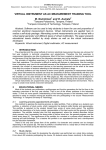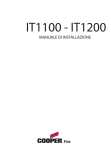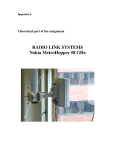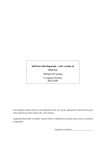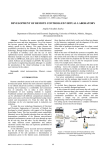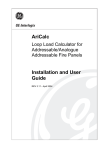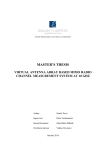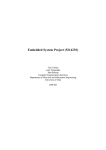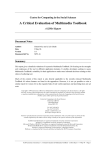Download Aumala
Transcript
HYPERTEXT TRAINING AID IN MEASUREMENT TECHNOLOGY O. Aumala Laboratory of Measurement and Information Technology Tampere University of Technology, Tampere, Finland Abstract: Software can be used to help students to learn concepts, structures, calculations, and use of measuring instruments. Such tools are useful particularly in situations, where there is very limited time for contact teaching. A careful design according to research on the studying process is essential. Experience shows that self-study repetition by using software training aid is fruitful for learning theoretical issues. Keywords: Training aid, Multimedia, Self-study 1 INTRODUCTION There are situations, where contact teaching is not sufficient to learn properly concepts, structures, theories, or practical applications. This problem is very important for distance education e.g. through the Web. But even in more traditional cases similar difficulties can exist. The number of students attending a course may be so big that no classroom for the whole group is available. Or the difficulty is an overlapping of lectures of other courses, and the student can choose only some of them to listen to the teaching. Foreign students have the problem of following teaching given in a strange language. The Web is used increasingly for teaching theoretical issues. The most common method is to present texts, problems and their solutions in the Web in the form of Adobe Acrobat files. Modern HTML code can also present mathematical equations. This method is not very fruitful because the solutions are given directly without any guidance that could help the student to correct his/her mistakes. Measurement technology differs from many other subjects in a very fundamental way: a measurement means always something experimental. A period of laboratory work is very essential even for basic skills in measurement technology. But actual laboratory work may be preceded by some theoretical introduction, and this can be learnt remotely. Paper [1] presents how software means can help students in the use of virtual instruments, and how this software can be used as a preparative study material for practical laboratory work. These tools can be used also in the Web ([2] is an example), and they may be very useful particularly before the first laboratory courses. 2 BASIC THEORETICAL TOPICS Some common topics are present practically in all measurement tasks. They can be presented and studied theoretically. The contents of a basic textbook [3] indicates following topics: • types of scales of measurement • loading effect of the measuring instrument • problems caused by the waveform of the measurand (some cases of systematic error of AC measurement) • measurement chain • balance methods • quantisation • sampling • dynamic measurement (problem of response time and frequency) • signal processing • calibration, and • evaluation of measurement uncertainty. All topics cannot be dealt with thoroughly within a single course, but an understanding of their presence is essential for any engineer working in the field of measurement. 3 ROLE OF EXERCISE There is a long tradition to include guided exercises into theoretical courses. The learning properties of students vary, and particularly adult students often learn best by first reading a text and then working with exercises. If the number of students is big, individual guidance cannot be given. The exercises are done merely by asking students to solve a set of exercise problems and then by giving and explaining a case solution. This is efficient from the point of the teacher, but it is not so efficient from the point of the student. An ideal education method would be to follow the working of the student, to give rewarding feedback on correct steps taken, and to identify mistakes at once giving a hint how to find the correct way. 4 AUTOMATIC GUIDANCE A teacher or a tutor follows the working of the student. If an error happens, an experienced tutor can often guess what sort of mistake was done. The student may then confirm or deny the guess, and a way can be found how to proceed. If the guidance happens automatically, it would be better not to guess but to be sure about the mistake and to present an unconditional hint or advice. If this is not possible, the most probable mistakes should be presented in order of probability, one at a time. The student has then to decide whether the guess was correct or not. If it was correct, a corresponding hint should follow, otherwise the next guess should be proposed. What has been said above, makes clear that the formulation of the exercise problem is very important. The checks for a correct solution should be done often enough to be able to identify every possible type of mistake without ambiguities. If a mistake is found, an individual comment for this mistake should be given. An exercise can be designed as a flowchart, see the principle in Fig. 1. All relevant steps are presented first, then checks for intermediate results, and finally hints and confirmations of success. Step 1 Hints 1 Step 2 Check 1 Conf. 1 Check 2 Applause Hint 2 Figure 1. The structure of an exercise with automatic commenting. The design of interactive automatic exercises is a field for pedagogic research. Often this research cannot be made due to lack of resources or time. In this case the design should be done by an experienced teacher who is able to evaluate various possibilities and risks. 5 PROGRAMMING TOOLS From Fig. 1 it can be seen that the structure is quite simple. The programming of an interactive exercise can be done using many alternative programming tools. It is advisable to include text, figures, equations, etc. in the material presented to the user. Sound and videoclipses would also be helpful in some cases. These are however more tedious to prepare, and they also demand a more complicated software and equipment of the student. Hypertext can be used to guide students in a meaningful way. Students are asked to calculate a value or they are asked to choose among given alternatives. According to the response of the student the program can show new fields on the hypertext page giving hints or advice, or it can reward a good performance. A simple HTML page does not contain a possibility to use IF structure in its operation, but there are other environments where this can be done. The studied case was programmed with Multimedia ToolBook [4], which can be distributed freely as runtime version to the students. 6 EXERCISE COLLECTION The exercise collection [5] is intended to be used as study material for the first university course in measurement technology. This course includes 28 lecture hours, 14 hours mathematical exercises, and 3 laboratory exercises 3 hours each. The course is a mass course: the number of students is about 400 at a time, and even lectures have to be given in two parallel classes. There is a sort of contact teaching, but the classes are too big for any individual tutoring. The interactive exercise collection intends to complement the mathematical exercises. The exercise set includes problems of most important chapters of the textbook [3] of the course. It is recommended that the exercise set should be taken as a part of the repetition work before the final test of the course. The feedback from the students indicates that this form of education can complement the contact teaching in a meaningful way. It is quite generally evaluated as a good tool for final training. One student stated that the exercises had developed an understanding why it is necessary to evaluate the measurement uncertainty. 6.1 Covered topics The collection includes a page for choosing a problem. It is arranged as a hierarchical menu according to Fig. 2. Figure 2. Hierarchical menu of the exercise collection. Only the first submenu is shown here. 6.2 Types of exercises Most problems are formulated as mathematical tasks. An example is presented in Fig. 3. Figure 3. Typical mathematical task. In this example the main point is to make sure that the dimensions of the statistical parameters are understood. It is a clear benefit that one cannot pass this aspect, because the examples worked in courses of statistics often deal with plain numbers only. Another subtopic of this exercise is the indication and removing of those results which possibly have crude errors, and this is presented on another page that is coupled with this one by a hyperlink (the hotword “go”). An example of comments shown after an erroneous input is shown in Fig. 4. In this case there was a wrong value and dimension of the variance. After clicking the comment field an additional comment appears giving knowledge for determining the correct number of degrees of freedom. If the student meets difficulties that go beyond his/her skills, the solution may be called with a particular pushbutton. The solution becomes visible only after typing a confirmation; this hopefully prevents students from going too easily to the solution. Another type of exercises is a selection task. This has been used in the handling of the types of measurement scales, see Fig. 5. The experience tells that a calculation task may be safer than a selection task from the point of view of learning. It seems to be too easy to try to guess a selection! Figure 4. An example of a comment field. Figure 5. A selection task. This is the first task of a multitask exercise. 6.3 Distribution of the collection The first version of the collection was distributed on floppy disks. The installation package was prepared for installing the exercise collection and the runtime version of the application programme. It also added a programme group and a starting icon into the start menu/program manager. After the testing period the software was modified. The latest version [5] is a shareware software and is distributed through the Web. Most students have an individual access to it. 7 DISCUSSION The paper presents a hypertext exercise collection used in a first university course of measurement technology. The structures used for interactive use, the exercise types used and experience given by students are presented. The author has an opinion that this sort of interactive study material could be used together with distributed textbooks as study material. If the professors of co-operating universities organise their work in a suitable way, this could result in a joint international education activity. REFERENCES [1] Numminen, M., Aumala, O., Virtual Instrument as AC Measurement Training Tool. To be presented at IMEKO XVI in Vienna, 2000 [2] T&M Educators Corner: Interactive Fundamentals Experiments. http://www.tmo.hp.com/tmo/ iia/edcorner/English/Director.html, 3. September 1999. [3] Aumala, O., Fundamentals in Measurement Technology (Mittaustekniikan perusteet). 8. edition, Otatieto, Helsinki 1999, 223 p. (in Finnish). [4] Toolbook. User Manual. Asymetrix Corporation, Bellevue, Washington 1994. [5] Aumala, O., Interactive Exercises in Measurement Technology. Version 1.2b, Tampere University of Technology, course 75116 Measurement Technology, ISBN 952-15-0291-6. http//mit.tut.fi/books/perusteet/ , 11. October 1999. AUTHOR: Prof. Olli Aumala, Tampere University of Technology, Laboratory of Measurement and Information Technology. P.O.Box 692, 33101 Tampere, Finland, Phone: +358 3 365 2483, Fax +358 3 365 2171, E-mail: [email protected]






